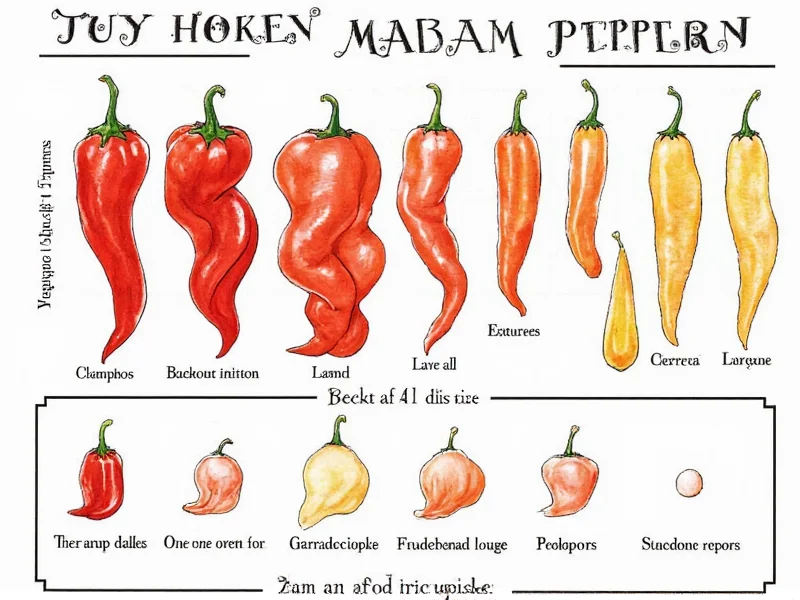A comprehensive hot pepper chart serves as an essential reference for anyone working with chili peppers, whether you're a home cook experimenting with new recipes, a gardener selecting varieties to grow, or a food professional developing menu items. Understanding the precise heat levels of different peppers prevents culinary disasters and ensures consistent results in spicy dishes.
Understanding the Scoville Heat Scale
Developed by pharmacist Wilbur Scoville in 1912, the Scoville Organoleptic Test originally measured pepper heat through human taste panels diluting pepper extracts until the heat became undetectable. Today, high-performance liquid chromatography (HPLC) provides precise measurements of capsaicinoids—the compounds responsible for heat—in Scoville Heat Units (SHU). This scientific approach has replaced subjective human testing while maintaining the familiar SHU scale that consumers recognize.
Complete Hot Pepper Heat Reference Chart
| Pepper Variety | Scoville Heat Units (SHU) | Common Uses | Flavor Profile |
|---|---|---|---|
| Bell Pepper | 0 SHU | Salads, stuffed peppers, stir-fries | Sweet, vegetal, crisp |
| Pepperoncini | 100-500 SHU | Pickling, salads, sandwiches | Mildly tangy, slightly bitter |
| Poblano | 1,000-2,000 SHU | Chiles Rellenos, mole sauces | Earthy, rich, slightly sweet |
| Jalapeño | 2,500-8,000 SHU | Salsas, nachos, pickled peppers | Grassy, bright, vegetal |
| Serrano | 10,000-23,000 SHU | Pico de gallo, hot sauces | Sharp, crisp, clean heat |
| Cayenne | 30,000-50,000 SHU | Spice blends, hot sauces | Sharp, pungent, woody |
| Tabasco | 30,000-50,000 SHU | Tabasco sauce, marinades | Vinegary, fruity, tangy |
| Habanero | 100,000-350,000 SHU | Tropical salsas, Caribbean dishes | Fruity, floral, citrus notes |
| Ghost Pepper (Bhut Jolokia) | 800,000-1,041,427 SHU | Extreme hot sauces, challenges | Smoky, sweet, then intense heat |
| Carolina Reaper | 1,400,000-2,200,000 SHU | Competitive eating, specialty sauces | Fruity upfront, then searing heat |
Key Factors Affecting Pepper Heat Levels
When consulting a comprehensive hot pepper heat chart, it's important to understand that actual heat can vary significantly based on several factors:
- Growing conditions: Soil quality, climate, and water stress can increase capsaicin production
- Ripeness: Fully ripe peppers often contain more capsaicin than unripe ones
- Plant genetics: Even within varieties, heat levels can differ between individual plants
- Part of the pepper: The placenta (white ribs) contains the highest concentration of capsaicin, not the seeds
Practical Applications of a Pepper Heat Reference Guide
Understanding how to apply hot pepper chart information makes all the difference in culinary success. When substituting peppers in recipes, consider both heat level and flavor profile. For example, while both habaneros and Scotch bonnets fall in the 100,000-350,000 SHU range, Scotch bonnets have a distinct tropical fruitiness that works better in Caribbean jerk sauces.
Professional chefs use detailed hot pepper charts to create balanced heat progression in multi-course meals. Home cooks benefit from understanding that removing seeds and membranes can reduce heat by up to 80% without sacrificing flavor. When preserving peppers through pickling or drying, remember that these processes can concentrate heat—dried peppers often measure higher on the Scoville scale than their fresh counterparts.
Safety Considerations with High-Heat Peppers
Working with extremely hot peppers requires proper precautions. Always wear gloves when handling peppers above 50,000 SHU, and avoid touching your face. The capsaicin in super-hot peppers can cause severe irritation to eyes and sensitive skin. If you experience burning, dairy products like milk or yogurt provide relief better than water, which spreads the oil-based capsaicin.
When creating homemade hot sauces using peppers from the upper ranges of the hot pepper chart, start with small quantities and taste incrementally. Remember that heat perception builds over time—you might not feel the full intensity of a Carolina Reaper for 30-60 seconds after consumption. Never consume pure capsaicin extract; even minute amounts can cause serious health issues.
Common Misconceptions About Pepper Heat Charts
Many people misunderstand how pepper heat charts work. Contrary to popular belief, smaller peppers aren't always hotter—size relates more to variety than heat intensity. The Scoville scale measures potential heat, but actual heat in individual peppers varies. Additionally, heat perception differs among people; what seems mild to one person might be overwhelming to another due to genetic differences in capsaicin receptors.
Another frequent error involves assuming that all peppers within a variety have identical heat. In reality, a single jalapeño plant can produce peppers ranging from 2,500 to 8,000 SHU. This natural variation is why professional kitchens often taste-test peppers before incorporating them into recipes requiring precise heat levels.
Using Pepper Charts for Gardening Success
Gardeners benefit significantly from understanding hot pepper charts when selecting varieties. If you're new to growing hot peppers, start with reliable mid-heat varieties like jalapeños or serranos before attempting super-hots. Remember that soil pH, sunlight exposure, and water stress directly impact final heat levels—peppers grown in slightly stressful conditions often develop higher capsaicin content.
When planning your garden layout, consider companion planting; basil and oregano can enhance pepper flavor development. For container gardening, smaller varieties like Thai chilis (50,000-100,000 SHU) work well, while larger super-hots like the Carolina Reaper require substantial space and consistent warmth to reach their maximum heat potential.
Conclusion
A well-constructed hot pepper chart provides invaluable guidance for navigating the complex world of chili peppers. By understanding both the numerical Scoville ratings and the practical factors that influence actual heat experience, you can confidently select, grow, and cook with peppers that match your desired heat profile. Whether you're creating a mild salsa or experimenting with super-hot varieties, this reference tool helps ensure culinary success while respecting the powerful chemistry of capsaicin.











 浙公网安备
33010002000092号
浙公网安备
33010002000092号 浙B2-20120091-4
浙B2-20120091-4